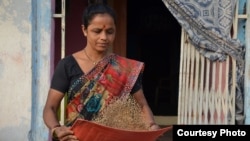Special new breeds of a drought-hardy grain may help reduce iron deficiency among the world’s poor, according to two new studies.
Iron deficiency anemia is the world’s most common nutritional disorder. The World Health Organization says half the pregnant women and two in five preschool children in developing countries are not getting enough iron.
Anemic adults can’t work to their full potential, and pregnant women are more likely to have complications in childbirth. And the effects on young children can permanent, according to pediatrician Michael Hambidge at the University of Colorado.
“One of the things we’re particularly concerned about with children is the major effects it has on brain development, and these are difficult to reverse later in life," said Hambidge.
Hambidge and colleagues tested flour made from a special variety of pearl millet, a grain that is well known in the dry lands of India and West Africa, where drought-tolerant crops are essential.
Researchers had raised the amount of iron in this variety with traditional breeding methods, not genetic modification. The process is called biofortification.
Hambidge’s colleagues in India prepared traditional meals with the biofortified flour and fed them to a group of 21 iron-deficient young children.
“A lot of this is eaten as chapatis and rotis [Indian flatbreads] and so on, but these are two-year-old children, and we found that they particularly liked the porridge," he said.
Children who ate the high-iron millet meals satisfied their daily requirements for the mineral. Nineteen children who ate similar meals made with regular millet did not.
The research was published in the Journal of Nutrition, along with another study of biofortified millet flour, this one in Benin. A group of 20 iron-deficient young women received about 70 percent of their daily requirement from traditional meals made with the biofortified flour. Regular millet, on the other hand, provided only 20 percent.
Pediatric researcher Stephanie Atkinson at McMaster University was not involved in the research. She wants to see larger studies showing high-iron biofortified crops actually do reduce anemia in vulnerable populations. But she says this research shows biofortification is a promising tool.
“It seems like the most logical, practical, feasible, easily deliverable way to get these nutrients that are of the greatest deficiency for the masses of people in underdeveloped countries," said Atkinson.
And experts say millet in particular is a good crop to reach some of the most vulnerable because it is typically cheaper than other grains. Plus, it needs very little rainfall, a growing concern as climate change alters precipitation patterns worldwide.
The first high-iron biofortified pearl millet is already on the market in India, and researchers are working to commercialize other varieties elsewhere in the developing world.
Iron deficiency anemia is the world’s most common nutritional disorder. The World Health Organization says half the pregnant women and two in five preschool children in developing countries are not getting enough iron.
Anemic adults can’t work to their full potential, and pregnant women are more likely to have complications in childbirth. And the effects on young children can permanent, according to pediatrician Michael Hambidge at the University of Colorado.
“One of the things we’re particularly concerned about with children is the major effects it has on brain development, and these are difficult to reverse later in life," said Hambidge.
Hambidge and colleagues tested flour made from a special variety of pearl millet, a grain that is well known in the dry lands of India and West Africa, where drought-tolerant crops are essential.
Researchers had raised the amount of iron in this variety with traditional breeding methods, not genetic modification. The process is called biofortification.
Hambidge’s colleagues in India prepared traditional meals with the biofortified flour and fed them to a group of 21 iron-deficient young children.
“A lot of this is eaten as chapatis and rotis [Indian flatbreads] and so on, but these are two-year-old children, and we found that they particularly liked the porridge," he said.
Children who ate the high-iron millet meals satisfied their daily requirements for the mineral. Nineteen children who ate similar meals made with regular millet did not.
The research was published in the Journal of Nutrition, along with another study of biofortified millet flour, this one in Benin. A group of 20 iron-deficient young women received about 70 percent of their daily requirement from traditional meals made with the biofortified flour. Regular millet, on the other hand, provided only 20 percent.
Pediatric researcher Stephanie Atkinson at McMaster University was not involved in the research. She wants to see larger studies showing high-iron biofortified crops actually do reduce anemia in vulnerable populations. But she says this research shows biofortification is a promising tool.
“It seems like the most logical, practical, feasible, easily deliverable way to get these nutrients that are of the greatest deficiency for the masses of people in underdeveloped countries," said Atkinson.
And experts say millet in particular is a good crop to reach some of the most vulnerable because it is typically cheaper than other grains. Plus, it needs very little rainfall, a growing concern as climate change alters precipitation patterns worldwide.
The first high-iron biofortified pearl millet is already on the market in India, and researchers are working to commercialize other varieties elsewhere in the developing world.




